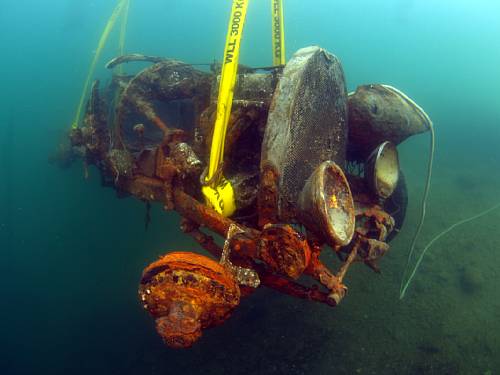
That will be a project... There is only about 22% left of the 1925 Bugatti 22 "Brescia" but the estimate for lot #250 at the January 23 Bonhams auction is €70,000 to €90,000 ($100000 to $130000).
Crazy? Not if you consider the sale is to benefit a foundation seeking to combat juvenile violence and that "unknown" Bugatti finds are pretty much unheard of anymore.
The original owner of this Bugatti is thought to have been a Swiss/Polish architect named Marco Schmuklerski, Schmuklerski lived in Ascona, on the Swiss end of Lake Maggiore and abandoned the car at a construction site in 1936. Eventually fees and taxes piled up and it was thought best to take the handbrake off and roll the car into the lake.
The Bugatti sat undiscovered until 1967 when it was first found by divers... you can read the whole story after the jump.
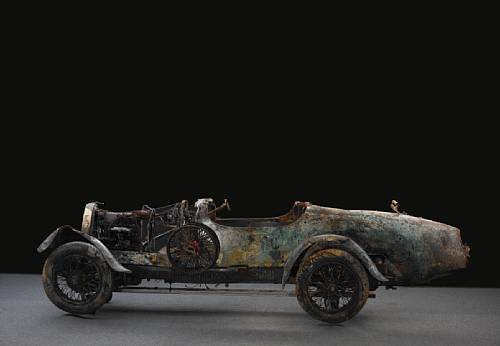

No reserve, 1925 Bugatti Brescia Type 22 Roadster
Chassis no. 2461
Engine no. 879
Sold in aid of the Fondazione Damiano Tamagi
Over the course of the past few months, the car offered here has become one of the most celebrated of all Bugattis, having lain submerged beneath the waters of Lake Maggiore in Switzerland for more than 70 years. The whereabouts of the sunken Bugatti had been known to the local sub aqua club for many years but in February 2008 a tragedy occurred that would eventually lead to its retrieval.

On the 1st of that month, Damiano Tamagni was attacked by three youths and beaten so severely that he later died from his injuries. Damiano and his father Maurizio were both members of the local sub aqua club in Ascona (Centro Sport Subacquei Salvataggio Ascona, CSSS) and it was decided to raise the Bugatti and use the funds from its sale to further the work of a charity set up in Damiano's name, 'Fondazione Damiano Tamagi', which seeks to address the issue of juvenile violence.
But how did the Bugatti come to be in Lake Maggiore in the first place? Subsequent research has uncovered much of its history. On the 11th April 1925, chassis number '2461' was registered in Nancy, France in the name of Georges Paiva, 49 Rue des Dominicains with the number '8843 N 5'. A small brass plate found on the car after its removal from the lake bears the name 'Georges Nielly, 48 Rue Nollet, Paris' but the registration plate is only partly legible, the last digits being 'RE 1'. This registration was issued in Paris between May and June 1930, which perhaps indicates that Georges Nielly bought the car earlier in 1930 at Nancy and had it registered in Paris in his name. These French registration plates have remained on the Bugatti ever since.
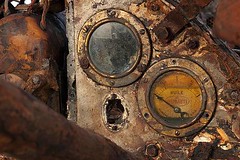 The Bugatti chassis number plate is missing, as is the enamel Bugatti radiator badge. Apart from that, all the relevant numbers are to be found in their usual places. The chassis number '2461' is on the round boss, located on the right front engine bearer (on the side of the exhaust manifold and steering-box) while the engine number '879' is visible on the little round boss, located on top in the middle of the cam box, as well as at the front face of the lower crankcase, next to the water pump.
The Bugatti chassis number plate is missing, as is the enamel Bugatti radiator badge. Apart from that, all the relevant numbers are to be found in their usual places. The chassis number '2461' is on the round boss, located on the right front engine bearer (on the side of the exhaust manifold and steering-box) while the engine number '879' is visible on the little round boss, located on top in the middle of the cam box, as well as at the front face of the lower crankcase, next to the water pump.The gearbox bears the number '964' at the back as well as the usual place on the cover. The rear axle has no number, which is normal for a Bugatti Brescia, but the ratio is stamped on the central casing and reads '12 x 45'. The radiator is made by Chausson, as indicated on a plate just above the cranking handle, while the two rear spring carriers still bear the little brass plates with 'EB, Bugatti, Molsheim (Alsace)' on them. Contrary to the factory data, which mentions a Solex carburettor, the actual carburettor on the car is a bronze Zenith, correct for this type of Bugatti. The two magnetos (twin ignition) are made by SEV and mounted in the middle of the dashboard as usual for this type of car.
There are indications that the body may have been modified or replaced, the first one being, probably, a simple racing body lacking electrics and mudguards. The valances below the bonnet are in two pieces, where normally they would be in one piece, while the mudguards are slightly flared at the rear, which is unusual for 1925. All this possibly indicates a modified or new body made at the end of the 1920s.
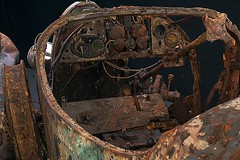 So far, it has not been possible to determine with certainty the identity of the Bugatti's owner in Ascona. However, the most likely candidate is Marco (Max) Schmuklerski, a Zurich-born architect of Polish descent. He is known to have stayed in Ascona from 17th July 1933 until 25th August 1936 when he left and returned to Zurich. At Ascona he designed, among other buildings, the 'Casa Bellaria' an apartment block that has only recently been demolished. If Marco Schmuklerski studied architecture at the famous Beaux Arts school in Paris, it is possible that he bought the Bugatti from Georges Nielly and brought it back to Switzerland but without paying any import duties. It is also possible that he acquired the car from a French tourist (or client) at Ascona. Whatever the case, the Bugatti has always been driven in Switzerland with its last French plates and import duties have never been paid. Nor has the car ever been registered with Swiss plates.
So far, it has not been possible to determine with certainty the identity of the Bugatti's owner in Ascona. However, the most likely candidate is Marco (Max) Schmuklerski, a Zurich-born architect of Polish descent. He is known to have stayed in Ascona from 17th July 1933 until 25th August 1936 when he left and returned to Zurich. At Ascona he designed, among other buildings, the 'Casa Bellaria' an apartment block that has only recently been demolished. If Marco Schmuklerski studied architecture at the famous Beaux Arts school in Paris, it is possible that he bought the Bugatti from Georges Nielly and brought it back to Switzerland but without paying any import duties. It is also possible that he acquired the car from a French tourist (or client) at Ascona. Whatever the case, the Bugatti has always been driven in Switzerland with its last French plates and import duties have never been paid. Nor has the car ever been registered with Swiss plates.The story going around Ascona is that Marco Schmuklerski left in 1936, leaving behind the Bugatti, which was stored in the yard of a local building contractor, Barra. Its owner at this time is not known, but the local customs officers knew of the car's existence and insisted on payment of the import duties owed. At that point these duties may have amounted to more than the value of the Bugatti, which was 11 years old and well used. In the case of non-payment of the duties, the car had to be destroyed and the simplest way to do so was to tip it into the nearby lake. To facilitate its recovery the Bugatti was attached to a heavy chain, but when this finally corroded away the car fell to the lakebed at a depth of 53 metres.
 It remained there, undiscovered, until 18th August 1967 when diver Ugo Pillon located the mythical Bugatti, which was lying on its left side, partly buried in the mud. Pillon had been searching for it for some time and after its rediscovery the car became a popular target members of the local sub aqua club. On 12th July 2009, after a 73-year sojourn in Lake Maggiore, the Bugatti was finally rescued from the lake by Jens Boerlin and his comrades from Ascona's sub aqua club. Local dignitaries and members of the Bugatti Club Suisse were in attendance, and the whole story was covered in a report by Renato de Lorenzi shown on Television Ticinese (RSI 1) on 23rd July 2009.
It remained there, undiscovered, until 18th August 1967 when diver Ugo Pillon located the mythical Bugatti, which was lying on its left side, partly buried in the mud. Pillon had been searching for it for some time and after its rediscovery the car became a popular target members of the local sub aqua club. On 12th July 2009, after a 73-year sojourn in Lake Maggiore, the Bugatti was finally rescued from the lake by Jens Boerlin and his comrades from Ascona's sub aqua club. Local dignitaries and members of the Bugatti Club Suisse were in attendance, and the whole story was covered in a report by Renato de Lorenzi shown on Television Ticinese (RSI 1) on 23rd July 2009.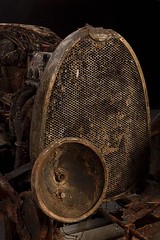 The Bugatti was transferred by crane onto a trailer for inspection by the sizeable crowd of onlookers. Its long immersion in the lake had resulted in extensive deterioration, ferrous components being badly affected, particularly on the car's exposed right-hand side. Other materials like wood, aluminium, brass, rubber, etc have survived in much better condition. It would, of course, be possible to restore the car, but it has been estimated that only some 20% of the original is reusable. Alternatively, a faithful replica could be created, using '2461' as a pattern, for approximately the same cost as a full restoration. Arguably, it would be more appropriate to preserve the Brescia in its current state for static display, but that is for the fortunate new owner to decide.
The Bugatti was transferred by crane onto a trailer for inspection by the sizeable crowd of onlookers. Its long immersion in the lake had resulted in extensive deterioration, ferrous components being badly affected, particularly on the car's exposed right-hand side. Other materials like wood, aluminium, brass, rubber, etc have survived in much better condition. It would, of course, be possible to restore the car, but it has been estimated that only some 20% of the original is reusable. Alternatively, a faithful replica could be created, using '2461' as a pattern, for approximately the same cost as a full restoration. Arguably, it would be more appropriate to preserve the Brescia in its current state for static display, but that is for the fortunate new owner to decide.No reserve
Estimate: €70,000 - 90,000

No comments:
Post a Comment